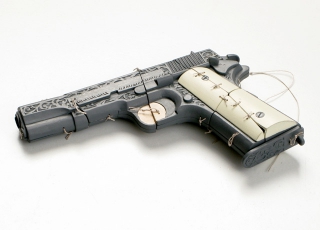A friend called our attention to the works of Peter Sauerer: his wooden sculptures are often in a small scale and address history, celebrities and our memory and imagination. For this, he is often making use of irony if not mockery without trivialising his subjects. The spatially small works condense the issues and commit the viewer to take a thorough look at them.

Born in 1958, the artist was a student in the master class of Professor Eduardo Paolozzi. Besides wood as his primary material for his works, Sauerer uses string and sometimes paper and iron sheet. The string holds together the single elements: the guns and cars seem to be broken, but also jointed. Many works are highly detailed, may it be the people or equipment shown. Some segments in the accurately worked models are just bare wood, just to remind the viewer of the artificiality, but also of the rawness – of the material used, but also of man.
Consistently, there is an examination of war: may it be a British Mk. V tank from the First World War, armoured trains or warships such as the Russian armoured cruiser Rurik, built in 1906. The artist also made guns (2,100 € each) and their bullets, for which he used specific ones, e.g. the famous German 08, a Colt M1911 (the US standard sidearm, not just in the Second World War), including a custom-built version (it could have been owned by General Patton) or (not just) James Bond’s Walther PPK: with such a weapon, the West-German policeman and Stasi agent Karl-Heinz Kurras killed the student Benno Ohnesorg on 2 June 1967, and even Adolf Hitler shot himself with a PPK.
Cars play an important role in Sauerer’s work, e.g. the “Parade Cars”, but also works in “boxes”. The former not only include Hitler (6,200 €) and Göring (5,800 €), but also Juan und Evita Perón or Siegfried Buback’s Mercedes Benz, in which he was murdered by the Red Army Faction on 7 April 1977, together with his driver Wolfang Göbel and Georg Wurster. In his group of works “boxes”, the events shown seem to be moulded in wood: only parts of the bodies and material protrude from the wood. There are many historic links: “Albert Speer and his children at Obersalzberg“, “Baldur von Schirach at the Nuremberg Reichsparteitag (Nazi party rally) 1933″ or “John F. Kennedy in Dallas, 1963″.
Further works in this group are the “Wahre Begebenheiten” (true events): the dock of the Nuremberg Trials, “Burning the books in Hamburg 1936″, “Leni Riefenstahl at the Nuremberg Reichsparteitag 1934″. Contemporary events are shown by Sauerer, too, e.g. the box “Final Journey – GIs in Iraq” has 8 coffins, emblazoned with US flags, together with soldiers and civilians. In the work “Final Journey – Rafik Hariri“, only the coffin of the politician that has been murdered on 14 February 2005 sticks out of the wooden matter, together with the pallbearers’ arms, holding it over their heads.
Sauerer’s works can be as re respectfull as unfilial; they are both fragile and firm like our memories; they address true events and absurd situations; they are exact in detail and allow for associations.
Peter Sauerer appears at the following galleries:
Thomas Rehbein Galerie, Köln
Galerie Michael Heufelder, München
Fine German Gallery, Frankfurt/Main




















